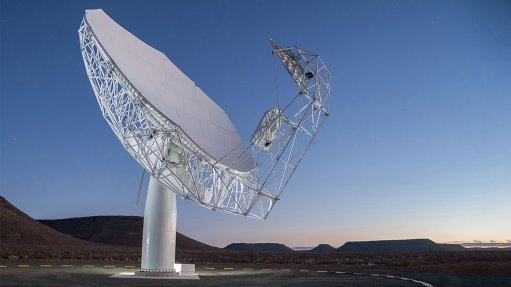
The first MeerKAT antenna
Photo by: SKA SA
South African Science and Technology Minister Derek Hanekom formally launched the first dish of the country’s MeerKAT radio telescope array in the Karoo, some 90 km west of the small town of Carnarvon, on Thursday. When completed, MeerKAT will have 64 such antennas.
“The MeerKAT is something concrete,” Hanekom told Engineering News Online on Wednesday. “It is a wholly South African designed and funded project. MeerKAT will be the world’s largest radio telescope when it is commissioned. It is a demonstration of our own South African capabilities.”
The dish is an offset Gregorian design with a diameter of 13.5 m and the complete antenna is 19.5 m tall and weighs 42 t. The design means that there are no struts over the dish which could reduce or scatter incoming radio waves, thus increasing the sensitivity of the antenna.
When completed, all the MeerKAT dishes will be connected by 170 km of optical fibre cable and will be operated together as a single instrument from a control room in Cape Town. MeerKAT is designed to be integrated into the international Square Kilometre Array (SKA) radio telescope, which will be co-hosted by South Africa and Australia.
“In just two years from now, 64 dishes will be standing there [in the Karoo],” enthused Hanekom. They will be in addition to the seven, smaller and differently designed, dishes of the prototype KAT-7 array, which has now transitioned into an operational scientific instrument.
When Phase 2 of the SKA is developed, outstations will also be placed in other countries, including eight other African states. These are Botswana, Ghana, Kenya, Madagascar, Mauritius, Mozambique, Namibia and Zambia.
Hanekom also officially opened the MeerKAT Karoo Array Processor Building, which is a high-technology data processing centre built at the Karoo observatory site. The building is below ground level to help shield the dishes from radio frequency interference from the computers, processors and other electronic and electrical equipment housed in it. In addition, within the building these systems are housed in shielded rooms.
The launch and opening were witnessed by Ministers, Deputy Ministers and other representatives of the eight African SKA partner countries, the director-general of the UK-based international SKA Organisation, representatives of SKA member countries and senior officials of SKA South Africa (SKA SA), amongst others.